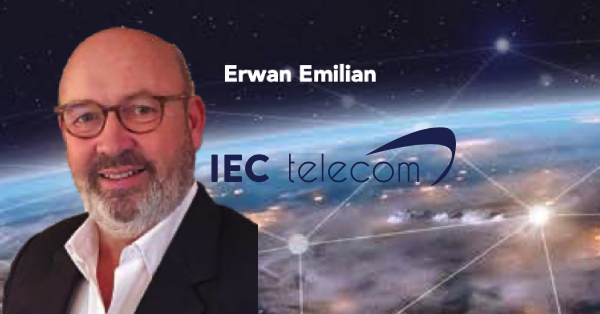Erwan Emilian, CEO of IEC Telecom Group, outlines how transformations in the satellite communications industry are set to impact the maritime industry
Satellite connectivity is transforming marine communications – a rapidly growing global industry that is currently estimated to be worth $4,421 million and, with a compound annual growth rate of 7.8%, is forecasted to reach $9,351 million by 2032. A massive paradigm shift is revolutionising the way that maritime companies operate, where the focus is switching from bandwidth capacity alone to viewing satcom ‘As-a-Service’.
The march of satcom is set to continue. The global satcom services market is predicted to reach $141 billion by 2030, driven by an expansion in the number of operators, that will inevitably lead to a fall in airtime prices, and by the development of advanced technologies such as IoT, AI, and blockchain, which has already resulted in considerable expansion of the global orbital infrastructure.
I predict that flat antennas powered by LEO satellite constellations will soon disrupt the communications market. Offering higher-speed connectivity over cost-effective services and terminals, flat antenna sales are estimated to grow to $11 billion over 1.4 million terminals by 2028. Already in 2022, two major flat panel antennas manufacturer, one of which represents LEO constellation, are producing thousands per week. It is expected that most of the revenue will derive from applications (up to 94%).
Recognising this trend, IEC Telecom Group, an international provider and integrator of satellite communications services, has developed breakthrough applications for a range of operations such as remote maintenance, surveillance, videoconferencing, telemedicine, and more. This is driven by the understanding that optimised applications save businesses data, time, and cost and account for 94% of the revenue gain from this game-changing scenario in satellite communications.
The adoption of new LEO-based communication systems with flat antennas is gaining momentum for land use, the technology will rapidly become mainstream for maritime use. Benefits are quite straightforward: the cost of LEO terminals is drastically lower as compared to GEO alternatives; low latency offers stable connectivity for specialised apps; lastly, compact size enables this connectivity even for small boats.
While the integration of LEO- powered technology in the maritime sector is in its early stage, traditional GEO VSAT remains the preferred technology for dedicated connectivity in the marine environment. The demand for ‘always-on’ connectivity is fuelling the growth of the global GEO- empowered VSAT maritime market, which is projected to reach $2,962 million by 2030.
With constant connectivity, there is now a significant emphasis on digital decarbonisation efforts in the maritime sector. Digitally enabled vessels empower decision-makers with data-driven recommendations. From performance tracking to asset safety, data relevant to ship management is made available to vessel operators to optimise routes and decrease fuel consumption. This eventually leads to lowering emissions, paving the way for a greener future. As more vessel operators invest in digital decarbonisation, not only can they increase their operational efficiency and improve asset visibility, but they can also sustainably gain a competitive edge.
Likewise, the demand for D2D (direct satellite-to-device connectivity) connectivity – where connectivity is provided directly to an individual’s mobile phone or device – is expected to grow among the new generation of seafarers. D2D connectivity can empower the crew with independent internet access that is no longer facilitated by their employer.
With the International Maritime Organization (IMO) highlighting the necessity to provide seafarers with communications to benefit their well-being, as well as the industry acknowledgement of the importance of crew connectivity in recruitment and retention, D2D looks set to become a sought-after solution.
Increased connectivity places greater emphasis on cyber security, another aspect of maritime communications which the IMO has highlighted as a required priority.
The success of cyber security implementation depends on policies which must be custom-made for each specific case because, for example, the needs for cyber security onboard a bulk carrier will differ from the needs of a fishing vessel. The role of satcom integrators, such as IEC Telecom has shifted from being enablers to specialists, helping customers
to leverage digitalisation without exposure to cyber-attacks.
All these emerging trends in the marine satellite communications market are being motivated by a future-oriented philosophy. Any development today brought to customers by IEC Telecom needs to target the requirements that businesses will have in five to 10 years’ time. We must look to the horizon!
Source: IEC Telecom






































